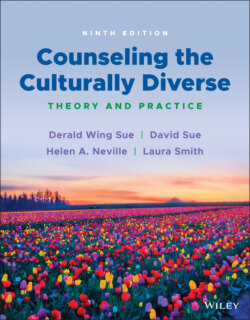Читать книгу Counseling the Culturally Diverse - Laura Smith L. - Страница 114
DILEMMA 3: THE PERCEIVED MINIMAL HARM OF MICROAGGRESSIONS
ОглавлениеOftentimes, when perpetrators are confronted about microaggressions, they accuse the victim of overreacting or being hypersensitive or touchy. Because the microaggressions are often invisible to perpetrators, they cannot understand how the events could cause any significant harm to the victims. Trivializing the impact of racial microaggressions can be an automatic, defensive reaction on the part of some White people, to avoid feeling blamed and guilty (Sue, Capodilupo, Nadal, & Torino, 2008). Despite a lack of acknowledgement by majority groups that everyday experiences of discrimination can be harmful to minorities, research is mounting to suggest otherwise: a large‐scale meta‐analysis reveals that perceived discrimination has cumulative and harmful effects on psychological well‐being (Schmitt, Branscombe, Postmes, & Garcia, 2014), and an American Psychological Association (2016) survey of over 3,000 respondents found that daily experiences of discrimination were significantly associated with poor physical health and high stress levels. Further, recent work links microaggressions to post‐trauma symptoms and depression (Auguste, Cruise, & Jimenez, 2021; Bryant‐Davis, 2018).
Multiple studies that look at racial microaggressions in the lived experience of African Americans find that the cumulative effect of these events is feelings of self‐doubt, frustration, isolation, powerlessness, and invisibility (Skinner‐Dorkenoo, Sarmal, Andre, & Rogheer, 2021). In a two‐week daily diary study of Asian American college students’ experiences of microaggressions, it was found that 78% experienced at least one microaggression, and the reporting of such events predicted higher negative affect and more somatic symptoms (Ong, Burrow, Fuller‐Rowell, Ja, & Sue, 2013). This supports earlier qualitative work that reported Asian Americans feeling belittled, angry, invalidated, invisible, and trapped by their experiences of racial microaggressions (Sue, Bucceri, et al., 2007). Multiple studies suggest that Latinx and Chicano/a students feel marginalized and frustrated by microaggressive experiences in educational settings (Huber & Cueva, 2012; Nadal, Mazzula, Rivera, & Fujii‐Doe, 2014; Ramirez, 2014).
Investigations link the experience of microaggressions on college campuses with serious behavioral and psychological consequences. For example, college students of color who experienced greater numbers of microaggressions were at increased risk for higher anxiety and binge drinking (Blume, Lovato, Thyken, & Denny, 2012). Other studies link the experience of microaggressions with low self‐esteem, depression, fatigue, pain, and lower energy levels (Nadal, Wong, Griffin, Davidoff, & Sriken, 2014; Nadal et al., 2017; Wong‐Padoongpat, Zane, Okazaki, & Saw, 2017). Specifically, microaggressions experienced in educational and workplace settings were found to be especially harmful to participants’ self‐esteem (Nadal, Wong, et al., 2014). Likewise, homonegative microaggressions were associated with lower self‐esteem, negative feelings about one's sexual orientation identity, and obstacles to developing one's sexual identity (Wright & Wegner, 2012). A higher number of homonegative microaggressions experienced has also been linked to a high level of post‐traumatic stress disorder (PTSD) symptoms (Robinson & Rubin, 2016).
